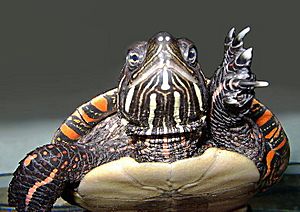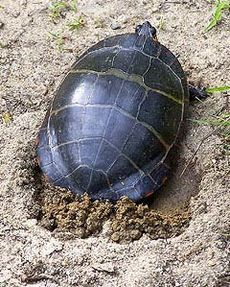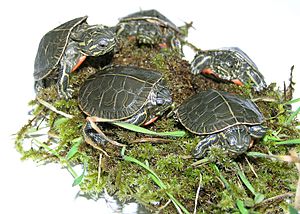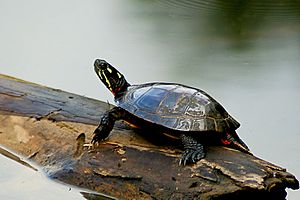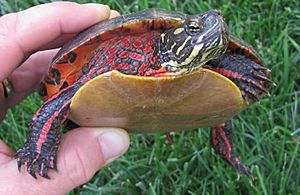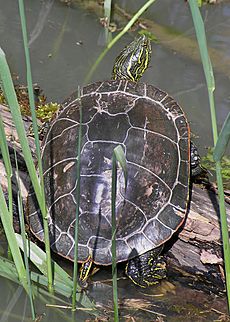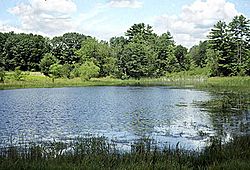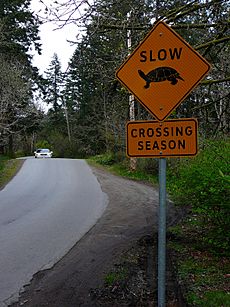Painted turtle facts for kids
Quick facts for kids Painted turtle |
|
|---|---|
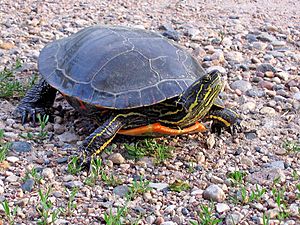 |
|
| Western painted turtle | |
| Conservation status | |
| Scientific classification | |
| Genus: |
Chrysemys
|
| Species: |
picta
|
| Subspecies | |
|
C. p. bellii |
|
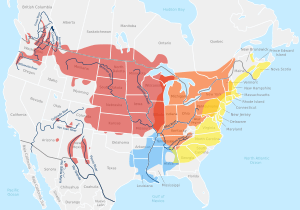 |
|
| Yellow: Eastern (C. p. picta) Orange: Midland (C. p. marginata) |
|
| Synonyms | |
|
Species synonymy
Subspecies synonymy
|
|
The painted turtle (Chrysemys picta) is the most common native turtle in North America. It lives in slow-moving fresh water, from southern Canada to northern Mexico, and from the Atlantic to the Pacific Ocean. This turtle is the only species in its group, called Chrysemys, which is part of the pond turtle family Emydidae. They have been around for a very long time, with fossils showing they lived 15 million years ago. There are four types, or subspecies, of painted turtles (eastern, midland, southern, and western) that developed during the last ice age.
Adult female painted turtles are usually 10 to 25 centimeters (4 to 10 inches) long; males are smaller. The turtle's top shell is dark and smooth, without a ridge. Its skin is olive to black with red, orange, or yellow stripes on its legs and neck. You can tell the subspecies apart by their shells: the eastern has straight lines on its top shell segments; the midland has a large gray mark on its bottom shell; the southern has a red line on its top shell; and the western has a red pattern on its bottom shell.
These turtles eat water plants, algae, and small water creatures like insects, crabs, and fish. Young turtles and eggs are often eaten by rodents, dogs, and snakes. But adult turtles have hard shells that protect them from most dangers. Painted turtles are active only during the day because they need warmth from the sun. They often bask for hours on logs or rocks. In winter, they hibernate, usually in the mud at the bottom of ponds. Turtles mate in spring and autumn. Females dig nests on land and lay eggs from late spring to mid-summer. Baby turtles grow until they are old enough to have their own babies: 2–9 years for males, and 6–16 years for females.
In old stories from Algonquian tribes, the colorful turtle was a clever trickster. Today, four U.S. states have chosen the painted turtle as their official reptile. Even though losing their homes and getting hit by cars have reduced their numbers, painted turtles can live in places changed by humans. This has helped them stay the most common turtle in North America. Adult turtles in the wild can live for more than 55 years.
Painted Turtle Appearance
The painted turtle's shell is 10 to 25 centimeters (4 to 10 inches) long. It is oval, smooth, and has a flat bottom. The top shell (called the carapace) is usually yellow, sometimes red, and might have dark spots in the middle. The turtle's skin is olive to black, with red and yellow stripes on its neck, legs, and tail. Like other pond turtles, the painted turtle has webbed feet to help it swim well.
The turtle's head is easy to spot. It has yellow stripes on its face, a big yellow spot and streak behind each eye, and two wide yellow stripes on its chin that meet at the tip of its jaw. The upper jaw looks like an upside-down "V" with a small, tooth-like point on each side.
Baby turtles have bigger heads, eyes, and tails, and rounder shells than adult turtles. Adult females are usually longer than males, measuring 10 to 25 cm (4 to 10 in) compared to males at 7 to 15 cm (3 to 6 in). For the same length, females have a taller, more rounded top shell. Females weigh about 500 grams (18 ounces) on average, while males weigh around 300 grams (11 ounces). Females are bigger to help them produce eggs. Males have longer front claws and a longer, thicker tail.
Types of Painted Turtles
Even though the different types of painted turtles (subspecies) mix where their homes meet, they are quite different in the main parts of their living areas.
- The male eastern painted turtle (C. p. picta) is 13 to 17 cm (5 to 7 in) long, and the female is 14 to 17 cm (6 to 7 in) long. Its top shell is olive green to black. It might have a light stripe down the middle and red marks on the edges. The plates (called scutes) on its top shell have light front edges and are in straight rows across its back. This is different from all other North American turtles. Its bottom shell is plain yellow or has light spots.
- The midland painted turtle (C. p. marginata) is 10 to 25 cm (4 to 10 in) long. It lives in the middle of the painted turtle's range and is the hardest to tell apart from the other types. Its bottom shell has a dark, balanced shadow in the center that changes in size.
- The southern painted turtle (C. p. dorsalis) is the smallest type, at 10 to 14 cm (4 to 6 in) long. It has a bright red stripe on its top shell. Its bottom shell is tan and has no spots or very few.
- The largest type is the western painted turtle (C. p. bellii), which can grow up to 26.6 cm (10.5 in) long. Its top shell has a pattern of light lines that look like a net. The top stripe seen in other types is missing or very faint. Its bottom shell has a large colored blotch that spreads to the edges and often has red colors.
| Eastern painted turtle C. p. picta |
Midland painted turtle C. p. marginata |
Southern painted turtle C. p. dorsalis |
Western painted turtle C. p. bellii |
|---|---|---|---|
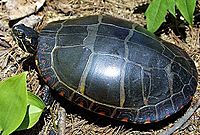 |
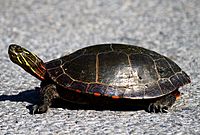 |
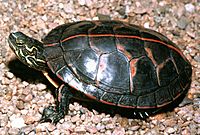 |
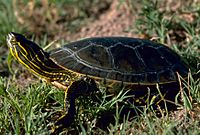 |
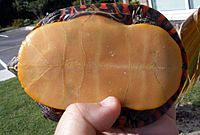 |
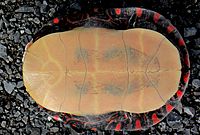 |
 |
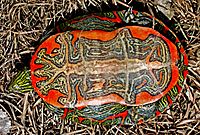 |
Similar Turtles
The painted turtle looks a lot like the red-eared slider, which is a common pet turtle. People often confuse them. You can tell the painted turtle apart because it is flatter than the slider. Also, the slider has a bright red mark on the side of its head (like an "ear") and a spotted bottom shell. The painted turtle does not have these features.
| Painted turtle | Red-eared slider |
|---|---|
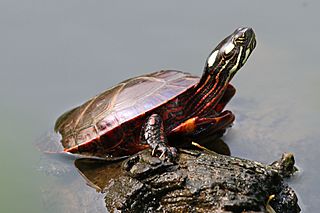 |
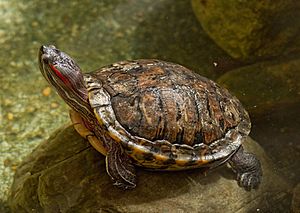 |
Painted Turtle Ecology
What Painted Turtles Eat
The painted turtle hunts for food along the bottom of the water. It quickly moves its head in and out of plants to make small creatures come out into the open water. Then, it chases them. If the prey is large, the turtle holds it in its mouth and tears it apart with its front feet. It also eats plants and skims the water surface with its mouth open to catch tiny food bits.
All types of painted turtles eat both plants and animals, but their diets are a bit different.
- The eastern painted turtle's diet is not studied as much as the others. It likes to eat in the water, but sometimes eats on land. The fish it eats are usually dead or hurt.
- The midland painted turtle mostly eats water insects and both large and small water plants.
- The southern painted turtle's diet changes as it gets older. Young turtles eat 13% plants, while adults eat 88% plants. This might mean that young turtles prefer small larvae and other prey, but can only get a lot of them when they are small.
- The western painted turtle's diet of plants and animals changes with the seasons. In early summer, 60% of its food is insects. In late summer, 55% is plants. The western painted turtle helps spread the seeds of white water-lilies. It eats the hard seeds, which can still grow after passing through the turtle's body, and spreads them through its waste.
| Common foods of the painted turtle | |||
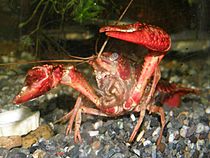 Crayfish |
 Dragonfly larva |
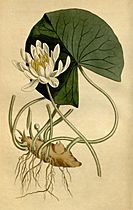 American water lily |
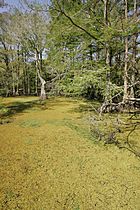 Duckweed (water surface) |
Who Eats Painted Turtles
Painted turtles are most at risk from predators when they are young. Nests are often raided, and the eggs are eaten by garter snakes, crows, chipmunks, squirrels, skunks, raccoons, and foxes. The small baby turtles are eaten by water bugs, bass, catfish, bullfrogs, snapping turtles, and different types of snakes. Herons, weasels, muskrats, and minks also hunt them.
When painted turtles become adults, their hard shells protect them from many animals. However, they can still be eaten by alligators, ospreys, crows, red-shouldered hawks, bald eagles, and especially raccoons.
Painted turtles protect themselves by kicking, scratching, biting, or urinating. Unlike land tortoises, painted turtles can flip themselves back over if they get turned upside down.
| Important predators of the painted turtle | |||||
Of eggs: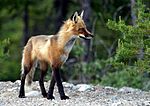 Red fox |
 Plains garter snake |
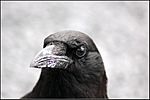 Crows |
Of hatchlings: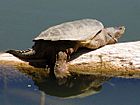 Common snapping turtle |
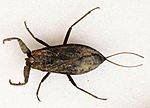 Water scorpion |
Of adults: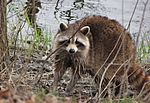 Raccoon |
Painted Turtle Life Cycle
Mating and Reproduction
Painted turtles mate in spring and fall when the water temperature is between 10 and 25 degrees Celsius (50 to 77 degrees Fahrenheit). Females start their egg-making cycles in mid-summer and release eggs the next spring.
Courtship starts when a male follows a female until they face each other. He then gently strokes her face and neck with his long front claws. If the female is ready to mate, she will do the same to him. They repeat this several times. The male moves away and then comes back to the female until she swims to the bottom, where they mate. The male is smaller than the female.
The female stores sperm inside her body to use for up to three sets of eggs (called clutches). The sperm can stay alive for up to three years. One clutch of eggs can even have babies from more than one father.
Egg-laying and Nests
Only female turtles dig nests, usually between late May and mid-July. The nests are shaped like a vase and are often dug in sandy soil, especially in sunny spots. Nests are usually within 200 meters (220 yards) of water, but can be as far as 600 meters (660 yards) away. Older females tend to nest further from the water. Nest sizes vary but are about 5 to 11 cm (2 to 4 in) deep. Females might return to the same nesting spots for several years in a row. If many females nest close together, their eggs are more likely to be found by predators.
The best body temperature for a female turtle when digging her nest is 29 to 30 degrees Celsius (84 to 86 degrees Fahrenheit). If the weather is not right, like a night that is too hot, she will wait until later to dig. Turtles in Virginia have waited three weeks to nest because of a hot, dry spell.
Before digging, the female sometimes does a strange thing. She presses her throat against the ground in different places. She might be checking for moisture, warmth, how the soil feels, or smells. She might also dig several fake nests, just like wood turtles do.
The female uses her back feet to dig. She can get so much sand and mud on her feet that it becomes hard for her to move, making her an easy target for predators. To make digging easier, she wets the area with water from her bladder. Once the nest is ready, the female lays her eggs in the hole. The fresh eggs are white, oval, porous, and flexible. The whole process can take four hours. Sometimes, she stays on land overnight before going back to her water home.
Females can lay up to five clutches of eggs per year, but two is a common average. About 30-50% of females in a group do not lay any eggs in a given year. In some northern areas, no females lay more than one clutch per year. Bigger females usually lay bigger eggs and more eggs per clutch. The number of eggs in a clutch varies among the subspecies. The two northern types, western and midland, are larger and lay more eggs per clutch (11.9 and 7.6 eggs, respectively) than the two southern types (southern 4.2 and eastern 4.9). Within each type, females living further north also lay more eggs.
Growth and Development
Eggs hatch in 72 to 80 days in the wild. In August and September, the young turtle breaks out of its egg using a special point on its jaw called an egg tooth. Not all babies leave the nest right away. Baby turtles born north of a certain line (from Nebraska to northern Illinois to New Jersey) usually stay in the nest over winter and come out the next spring.
The ability of baby turtles to survive winter in the nest has allowed the painted turtle to live further north than any other American turtle. The painted turtle is made to survive long periods of freezing temperatures. Its blood can stay supercooled (below freezing without turning to ice), and its skin can stop ice crystals from getting in from the ground. However, very hard freezes can still kill many baby turtles.
Right after hatching, turtles get their food from the egg yolk. About one to one and a half weeks after leaving their eggs (or the next spring if they stayed in the nest), baby turtles start eating to grow. Young turtles grow quickly at first, sometimes doubling their size in the first year. Growth slows down a lot when they can have babies and might stop completely. Growth rates often differ between groups of turtles in the same area, probably because of differences in their homes and food. Western painted turtles grow the fastest among all the types.
Females grow faster than males overall. In most groups, males can have babies when they are 2–4 years old, and females when they are 6–10 years old. The size and age when they can have babies increase the further north they live. At the northern edge of their range, males can have babies at 7–9 years old, and females at 11–16 years old.
Painted Turtle Behavior
Daily Routine and Basking
The painted turtle is a cold-blooded animal, meaning it controls its body temperature using its surroundings. It does this mainly by basking in the sun. Turtles of all ages bask to get warm, often with other types of turtles. Sometimes, more than 50 turtles can be seen on one log together. Turtles bask on many different things, usually logs, but they have even been seen basking on top of common loons that were sitting on eggs.
The turtle starts its day at sunrise, coming out of the water to bask for several hours. Once it is warm enough, it goes back into the water to find food. After getting cold again, the turtle comes out for one or two more times of basking and eating. At night, the turtle goes to the bottom of its water home or sits on something underwater and sleeps.
To be active, the turtle needs its body temperature to be between 17 and 23 degrees Celsius (63 to 73 degrees Fahrenheit). If it is fighting an infection, it can raise its temperature up to 5 degrees Celsius (8 degrees Fahrenheit) higher than normal.
Seasonal Routine and Hibernation
In the spring, when the water reaches 15 to 18 degrees Celsius (59 to 64 degrees Fahrenheit), the turtle starts actively looking for food. However, if the water temperature goes above 30 degrees Celsius (86 degrees Fahrenheit), the turtle will not eat. In the fall, the turtle stops looking for food when temperatures drop below the spring starting point.
During the winter, the turtle hibernates. In the north, they might be inactive from October to March. In the southernmost areas, they might not hibernate at all. While hibernating, the painted turtle's body temperature is usually around 6 degrees Celsius (43 degrees Fahrenheit). Warm weather can bring the turtle out of hibernation, and even in the north, some have been seen basking in February.
The painted turtle hibernates by burying itself. It might be at the bottom of a body of water, near the water in the shore-bank, in a muskrat burrow, or in woods or fields. When hibernating underwater, the turtle prefers shallow depths, no more than 2 meters (7 feet) deep. In the mud, it might dig down another 1 meter (3 feet). In this state, the turtle does not breathe air. However, if the water allows, it can get some oxygen through its skin. This species is one of the best-studied vertebrates that can survive long periods without oxygen. Its blood, brain, heart, and especially its shell have special ways to help it survive a lot of lactic acid buildup when there is no oxygen.
Movement and Travel
Painted turtles travel up to several kilometers at a time to find water, food, or mates. In summer, if it gets too hot or plants clog the shallow marshes, turtles might move to deeper, more permanent waters. Hundreds of turtles might move together in short trips over land. If heat and dry weather last a long time, the turtles will bury themselves in the mud. In very bad cases, they can die.
Turtles looking for food often cross lakes or travel straight down creeks. They have been seen crossing large ponds daily. Males travel the most, up to 26 kilometers (16 miles) between captures. Females travel the second most, up to 8 kilometers (5 miles). Young turtles travel the least, less than 2 kilometers (1 mile). Males move the most and are most likely to change wetlands because they are looking for mates.
Painted turtles can find their way home (called homing) by recognizing things they see. Many turtles can return to where they were caught after being released somewhere else. These trips might mean they have to travel over land. One experiment released 98 turtles several kilometers from their home wetland, and 41 of them returned. When living in one large body of water, painted turtles can find their way home from up to 6 kilometers (4 miles) away. Females might use homing to help them find good places to build their nests.
Painted Turtle Adaptations
- You often see painted turtles sitting on logs or rocks in the sun. This is called basking. By exposing their shell and skin to the sun, they absorb heat, raising their body temperature. This is important for digestion, metabolism, and overall health.
- Hibernation is perhaps one of the most incredible adaptations of painted turtles, especially for those living in northern climates. During hibernation, their heart rate slows down dramatically, their breathing almost stops, and their metabolism drops to a tiny fraction of its normal rate.
- Cloacal respiration is another of their amazing adaptations! During hibernation in the winter, when they are buried in the mud at the bottom of ponds, they can't come up for air. Instead, they can absorb oxygen directly from the water through specialized areas in their body, particularly around their cloaca (a single opening for waste and reproduction). This is crucial for surviving the winter underwater when oxygen levels in the water can be very low.
- They have good eyesight, especially for detecting movement. This helps them spot prey and predators in the water and on land.
- While they don't have external ears like mammals, they can detect vibrations in the water and on land. This helps them sense approaching dangers.
- They have a good sense of smell, which helps them locate food in the water and find suitable places to dig nests.
- Their ability to eat both plants (like aquatic weeds) and animals (like insects, worms, small fish, and tadpoles) means they can find food in many different parts of their habitat and at different times of the year. This flexibility is a great survival advantage.
Painted Turtle Distribution
Where Painted Turtles Live
The painted turtle is the most widespread turtle in North America. It is the only turtle whose natural home stretches from the Atlantic Ocean to the Pacific Ocean. It lives in eight of Canada's ten provinces, 45 of the 50 United States, and one of Mexico's 31 states. On the East Coast, it lives from the Canadian Maritimes to Georgia. On the West Coast, it lives in British Columbia, Washington, and Oregon. It is also found offshore on southeast Vancouver Island.
It is the northernmost American turtle, living in much of southern Canada. To the south, its range reaches the U.S. Gulf Coast in Louisiana and Alabama. In the southwestern United States, there are only scattered groups. It is found in one river in extreme northern Mexico. It is not found in parts of southwestern Virginia, nearby states, or north-central Alabama.
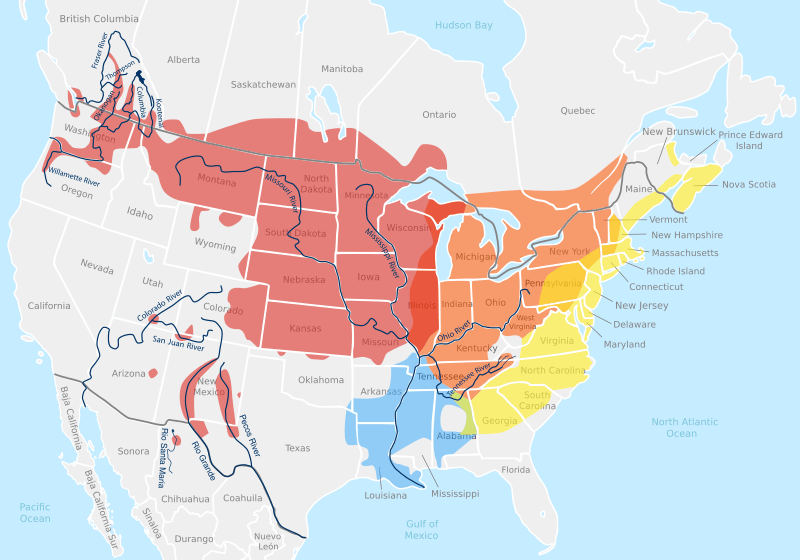
| Native range of the painted turtle (C. picta) Dark grey for national borders White for state and province borders Dark blue for rivers, only showing those in article |
Eastern (C. p. picta) Midland (C. p. marginata) Southern (C. p. dorsalis) Western (C. p. bellii) | Intergrade mixtures (large areas only) Mix of eastern and midland Mix of eastern and southern Mix of midland and western |
The lines between the four subspecies are not clear because the subspecies interbreed (mix) where their ranges meet. Many studies have been done in these border areas to look at these mixed turtles. Even with this mixing, the subspecies have their own general areas where they live.
Eastern Painted Turtle Range
The eastern painted turtle lives from southeastern Canada down to Georgia. Its western border is roughly the Appalachian Mountains. In the far north, it mostly stays in warmer areas closer to the Atlantic Ocean. It is not common in far northern New Hampshire and is only common in a strip about 50 miles from the coast in Maine. In Canada, it lives in New Brunswick and Nova Scotia, but not in Quebec or Prince Edward Island. To the south, it is not found in the coastal lowlands of southern North Carolina, South Carolina, or Georgia, or in southern Georgia in general or at all in Florida.
The eastern subspecies' range goes a little into east-central Alabama, where it mixes with the southern subspecies. In the northeast, there is a lot of mixing with the midland subspecies. In the southeast, the border between the eastern and midland is clearer because mountain ranges separate the subspecies into different river systems.
Midland Painted Turtle Range
The midland painted turtle lives from southern Ontario and Quebec, through the eastern U.S. Midwest states, to Kentucky, Tennessee, and northwestern Alabama. In Alabama, it mixes with the southern painted turtle. It is also found eastward through West Virginia, western Maryland, and Pennsylvania. The midland painted turtle seems to be moving east, especially in Pennsylvania. To the northeast, it is found in western New York and much of Vermont, and it mixes a lot with the eastern subspecies.
Southern Painted Turtle Range
The southern painted turtle lives from extreme southern Illinois and Missouri, mostly along the Mississippi River Valley, to the south. In Arkansas, it spreads west towards Texas, where it is found in the far northeast part of that state (the Caddo Lake area) and extreme southeastern Oklahoma (McCurtain County). It is found in much of Louisiana, where it reaches the Gulf of Mexico (in fresh water). Eastward, it is found in western Tennessee, northern Mississippi, and much of Alabama, including the city of Mobile on the Gulf Coast. A separate group in central Texas has been reported but is now thought to be non-native.
Western Painted Turtle Range
The western painted turtle's northern range includes southern parts of western Canada, from Ontario through Manitoba, Saskatchewan, Alberta, and British Columbia. In Ontario, the western subspecies is found north of Minnesota and directly north of Lake Superior. However, there is a 130 km (81 mi) gap east of Lake Superior (where winters are harshest) where no painted turtles live. So, Ontario's western subspecies does not mix with the midland painted turtle of southeastern Ontario. In Manitoba, the turtle is common and lives north to Lake Manitoba and the lower part of Lake Winnipeg. The turtle is also common in southern Saskatchewan. In Alberta, there might only be 100 individuals, all found very close to the U.S. border, mostly in the southeast.
In British Columbia, groups live inland in the areas around the Kootenai, Columbia, Okanagan, and Thompson river valleys. On the coast, turtles are found near the mouth of the Fraser River and a bit further north, as well as the bottom of Vancouver Island and some other nearby islands. Within British Columbia, the turtle's range is not continuous. High mountains block the turtles' movement from east to west within the province or from Alberta. Some old writings have shown isolated groups much further north in British Columbia and Alberta, but these were likely pets that were released.
In the United States, the western subspecies mixes with the midland subspecies in a wide area covering much of Illinois, a strip of Wisconsin along Lake Michigan, and part of the Upper Peninsula of Michigan (UP). Further west, the rest of Illinois, Wisconsin, and the UP are part of its main range, as are all of Minnesota and Iowa, and all of Missouri except a narrow strip in the south. All of North Dakota, almost all of South Dakota, and all of Nebraska are within its range. Almost all of Kansas is in its range; the border of that state with Oklahoma is roughly the species' range border, but the turtle is found in three counties of north-central Oklahoma.
To the northwest, almost all of Montana is in its range. Only a narrow strip in the west, along most of the Idaho border (which is at the Continental Divide), does not have turtles. Wyoming is almost entirely outside its range; only the lower elevation areas near the eastern and northern borders have painted turtles. In Idaho, turtles are found throughout the far north (upper half of the Idaho Panhandle). Recently, separate Idaho groups have been seen in the southwest (near the Payette and Boise rivers) and the southeast (near St. Anthony). In Washington state, turtles are common throughout the state in lower elevation river valleys. In Oregon, the turtle is native to the northern part of the state throughout the Columbia River Valley and the Willamette River Valley north of Salem.
To the southwest, the painted turtle's range is broken up. In Colorado, while its range is continuous in the eastern, prairie, half of the state, it is not found in most of the western, mountainous, part of the state. However, the turtle is confirmed to be in the lower elevation southwest part of the state (Archuleta and La Plata counties). From there, a group extends into northern New Mexico in the San Juan River basin. In New Mexico, the main distribution follows the Rio Grande and the Pecos River, two waterways that run north-south through the state. Within these rivers, it is also found in the northern part of Far West Texas. In Utah, the painted turtle lives in an area to the south (Kane County) in streams that flow into the Colorado River, though it is debated if they are native there. In Arizona, the painted turtle is native to an area in the east, Lyman Lake. The painted turtle is not native to Nevada or California.
In Mexico, painted turtles have been found about 50 miles south of New Mexico near Galeana in the state of Chihuahua. There, two trips found the turtles in the Rio Santa Maria, which is in a closed basin.
Human-Introduced Range
People releasing their pets are starting to establish the painted turtle outside its natural home. It has been introduced into waterways near Phoenix, Arizona, and to Germany, Indonesia, the Philippines, and Spain.
Painted Turtle Habitat
To live well, painted turtles need fresh water with soft bottoms, places to bask, and water plants. They make their homes in shallow waters with slow currents, like creeks, marshes, ponds, and the edges of lakes. The different types of painted turtles have developed different favorite places to live.
- The eastern painted turtle loves water very much. It only leaves the water when a dry spell forces it to move. Along the Atlantic, painted turtles have been seen in salty waters.
- The midland and southern painted turtles especially look for calm waters, usually lake shores and coves. They like shallow areas with lots of plants and can even handle some pollution.
- The western painted turtle lives in streams and lakes, like the other painted turtles. But it also lives in pasture ponds and roadside pools. It can be found as high as 1800 meters (5,900 feet) up.
Painted Turtle Population
In many parts of its range, the painted turtle is the most common turtle species. The number of turtles living in an area can range from 10 to 840 turtles per hectare (2.5 acres) of water. Warmer climates have more turtles, and how good the habitat is also affects how many turtles live there. Rivers and large lakes have fewer turtles because only the shore is a good home.
Adults are more numerous than young turtles in most groups. However, it is hard to count them because young turtles are harder to catch. The chance of a painted turtle surviving from an egg to its first birthday is only 19%. For females, the chance of surviving each year goes up to 45% for young turtles and 95% for adults. Male survival rates are similar but probably lower overall than females, which is why males generally do not live as long as females. Natural disasters can affect how many turtles of different ages there are. For example, a hurricane can destroy many nests, leading to fewer baby turtles the next year.
To understand how many adult painted turtles of different ages there are, scientists need good ways to study them. Turtles younger than four years old (up to 12 years in some groups) can be aged by looking at "growth rings" on their shells. For older turtles, some try to guess their age based on the size and shape of their shells or legs using math, but this way is less certain. The best way to study these long-lived turtles is to catch them, mark their shells permanently with a small notch, release them, and then catch them again in later years. The longest study, in Michigan, has shown that painted turtles can live more than 55 years.
The number of adult males and females in painted turtle groups is usually about equal. Many groups have slightly more males, but some have many more females. One group in Ontario has four females for every male. The sex of baby turtles depends on the egg temperature. During the middle third of incubation, temperatures of 23–27 degrees Celsius (73–81 degrees Fahrenheit) produce males. Any temperature above or below that produces females. It does not seem that females choose nesting spots to control the sex of their babies. Within a group, nests will vary enough to produce both male-heavy and female-heavy broods.
Painted Turtle Taxonomy
The painted turtle (C. picta) is the only species in its group, called Chrysemys. The larger family for Chrysemys is Emydidae, which are the pond turtles. Emydidae is divided into two smaller groups, and Chrysemys is part of the Deirochelyinae (Western Hemisphere) branch. The four types of painted turtles are the eastern (C. p. picta), midland (C. p. marginata), southern (C. p. dorsalis), and western (C. p. bellii).
The painted turtle's group name, Chrysemys, comes from old Greek words meaning "gold" (chryso) and "freshwater tortoise" (emys). The species name, pictus, comes from Latin for "colored". The subspecies name, marginata, is Latin for "border" and refers to the red marks on the outer part of the top shell. Dorsalis is Latin for "back", referring to the clear stripe on the back. And bellii honors English zoologist Thomas Bell. Another common name for the painted turtle on the East Coast is "skilpot," which comes from the Dutch word for turtle, schildpad.
How Painted Turtles Are Classified
The painted turtle was first described in 1783 by Johann Gottlob Schneider as Testudo picta. It was first called Chrysemys picta by John Edward Gray in 1855. The four subspecies were later recognized: the eastern by Schneider in 1783, the western by Gray in 1831, and the midland and southern by Louis Agassiz in 1857.
Until the 1930s, many biologists thought the painted turtle subspecies were actually full species within Chrysemys. In 1931, Bishop and Schmidt created the current "four in one" way of classifying the species and subspecies. They looked at measurements of turtles from all over the range and decided that what were thought to be separate species were actually just subspecies.
Since at least 1958, it was believed that the subspecies developed because they were separated geographically during the last ice age, about 100,000 to 11,000 years ago. At that time, painted turtles were split into three different groups: eastern painted turtles along the southeastern Atlantic coast; southern painted turtles around the southern Mississippi River; and western painted turtles in the southwestern United States. These groups were not completely separated for long enough, so they did not become entirely different species. When the glaciers melted about 11,000 years ago, all three subspecies moved north. The western and southern subspecies met in Missouri and interbred to create the midland painted turtle. This new type then moved east and north through the Ohio and Tennessee river basins.
Scientists have long argued about the groups of closely related turtles: Chrysemys, Pseudemys (cooters), and Trachemys (sliders). After 1952, some combined Pseudemys and Chrysemys because they looked similar. In 1964, based on skull and foot measurements, Samuel B. McDowell suggested all three groups should be merged into one. However, more measurements in 1967 showed this was not right. Also in 1967, J. Alan Holman, a scientist who studies fossils and reptiles, pointed out that even though the three turtles were often found together in nature and had similar mating habits, they did not crossbreed. In the 1980s, studies of turtle cell structures, body chemistry, and parasites further showed that Chrysemys, Pseudemys, and Trachemys should stay in separate groups.
In 2003, David E. Starkey and his team presented a new idea about the subspecies. Based on studying their mitochondrial DNA, they disagreed with the ice age theory. They argued that the southern painted turtle should be considered a separate species, C. dorsalis, and the other subspecies should all be grouped together without being different types. However, this idea was mostly not accepted because successful breeding between all subspecies was seen wherever they overlapped. Still, in 2010, the IUCN recognized both C. dorsalis and C. p. dorsalis as correct names for the southern painted turtle.
Painted Turtle Fossils
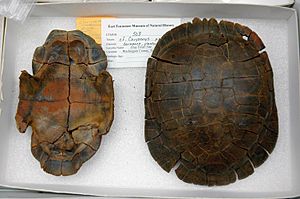
Even though we do not fully understand how the painted turtle evolved (what its ancestors were like and how its close relatives branched off), we find many painted turtle fossils. The oldest fossils, found in Nebraska, are about 15 million years old. Fossils from 15 million to about 5 million years ago are only found in the Nebraska-Kansas area. But more recent fossils are found in more places. Fossils older than 300,000 years are found in almost all of the United States and southern Canada.
Painted Turtle and Humans
Conservation Efforts
The painted turtle is currently listed as least concern by the IUCN. This means it is not in danger of disappearing. However, its numbers have gone down in some local areas.
The decrease in painted turtle numbers is not a sudden, big drop like that of the American bison. Instead, the turtle is classified as G5 (clearly widespread) in its Natural Heritage Global Rank. The painted turtle's high number of babies and its ability to live in polluted wetlands and man-made ponds have helped it keep its wide range. But human settlement in North America has reduced its overall numbers.
Only in the Pacific Northwest is the turtle's range shrinking. Even there, in Washington, the painted turtle is listed as S5 (clearly widespread). However, in Oregon, the painted turtle is listed as S2 (in danger), and in British Columbia, the turtle's groups in the Coast and Interior regions are called "endangered" and "of special concern."
Many things threaten the painted turtle, but we do not know exactly how much each one affects them. A main threat is habitat loss in different ways. For water homes, this includes wetlands drying up, logs or rocks (basking spots) being removed from the water, and plants along the shore being cleared. Clearing shore plants allows more predators to get to them or increases human foot traffic. For nesting areas, city building or planting can remove the sunny soil they need.
Another big human impact is roadkill—dead turtles, especially females, are often seen on roads in summer. Besides direct killing, roads can also separate some groups of turtles, making them genetically isolated. Some places have tried to reduce roadkill by building underpasses, highway barriers, and crossing signs. Oregon has started public education about turtle awareness, driving safely around them, and helping turtles cross the road.
In the West, bass, bullfrogs, and especially snapping turtles that humans have introduced have increased the number of baby turtles eaten. Outside the Southeast, where sliders are native, pet red-eared slider turtles that are released increasingly compete with painted turtles. In cities, more urban predators (raccoons, dogs, and cats) may affect painted turtles by eating their eggs.
Other concerns for painted turtles include too many being collected from the wild, released pets bringing in diseases or reducing genetic variability, pollution, boat traffic, fishing hooks (turtles are known to steal bait), being shot on purpose, and being crushed by farm machines or golf course lawnmowers. Global warming is a future threat that is not yet fully understood.
As the most common turtle in Nova Scotia, the eastern painted turtle is not listed under the Species at Risk Act for conservation needs.
Pets and Other Uses
"... we do not necessarily encourage people to collect these turtles. Turtles kept as pets usually soon become ill ... The best way to enjoy our native turtles is to observe them in the wild ... it would be better to take a picture than a 'picta'!"
A study of trade data showed that painted turtles were the second most popular pet turtles after red-eared sliders in the early 1990s. As of 2010, most U.S. states allow, but do not encourage, painted turtles as pets. However, Oregon forbids keeping them as pets, and Indiana does not allow their sale. U.S. federal law prohibits selling or transporting any turtle less than 10 cm (4 in) to limit human contact with salmonella. But a loophole for scientific samples allows some small turtles to be sold, and illegal selling also happens.
Keeping painted turtles as pets is similar to keeping red-eared sliders. Owners are told to give them enough space, a basking spot, and water that is regularly filtered and changed. According to Petco, these animals are not very suitable for children because they do not like to be held. Some hobbyists have kept turtles alive for decades.
Painted turtles are sometimes eaten but are not considered very good food. Even the largest type, the western painted turtle, is inconveniently small. Larger turtles are available for food. Schools often dissect painted turtles, which are sold by companies that provide biological specimens. These turtles often come from the wild but can also be bred in captivity. In the Midwest, turtle racing is popular at summer fairs.
Painted Turtle in Culture
"Whereas, the Painted Turtle is a hard worker and can withstand cold temperatures like the citizens of Vermont, and Whereas, the colors of the Painted Turtle represent the beauty of our state in autumn ... the General Assembly hereby recognizes the Painted Turtle as the official state reptile ..."
Native American tribes knew the painted turtle well. Young warriors were taught to recognize its splash into water as an alarm. The turtle was also part of their stories. A Potawatomi myth tells how talking turtles, "Painted Turtle" and his friends "Snapping Turtle" and "Box Turtle", outsmart the village women. Painted Turtle is the main character in the story. He uses his special markings to trick a woman into holding him so he can bite her. An Illini myth tells how Painted Turtle put on his colorful "paint" to attract a chief's daughter into the water.
As of 2010, four U.S. states have named the painted turtle their official reptile. Vermont honored the reptile in 1994, after students from Cornwall Elementary School suggested it. In 1995, Michigan followed, based on the idea from fifth graders in Niles who found out their state did not have an official reptile. In 2004, Illinois citizens voted to choose the painted turtle as their state reptile, and the legislature made it official in 2005. Colorado chose the western painted turtle in 2008, thanks to the efforts of two years of Jay Biachi's fourth-grade classes. In New York, the painted turtle almost won a statewide student election for state reptile in 2006, losing by a very small number of votes to the common snapping turtle.
In the border town of Boissevain, Manitoba, a 10,000-pound (4,500 kg) western painted turtle statue, Tommy the Turtle, is a roadside attraction. The statue was built in 1974 to celebrate the Canadian Turtle Derby, a festival with turtle races that ran from 1972 to 2001.
Another Canadian who admires the painted turtle is Jon Montgomery. He won the 2010 Olympic gold medal in skeleton (a type of sled) racing. He wore a painted turtle drawing on his helmet, which was easy to see as he slid down the hill. Montgomery, who also has a maple-leaf tattoo on his chest, explained that he promoted the turtle because he had helped one cross the road. BC Hydro mentioned Montgomery's action when talking about its own support for turtle conservation research in British Columbia.
Several private groups use the painted turtle as a symbol. Wayne State University Press has a publishing branch "named after the Michigan state reptile" that "publishes books on local topics of culture and history." In California, The Painted Turtle is a camp for sick children, started by Paul Newman. Painted Turtle Winery in British Columbia uses the turtle's "laid back and casual lifestyle" as part of its brand. There is also an internet company in Michigan, a guesthouse in British Columbia, and a café in Maine that use the painted turtle for business.
In children's books, the painted turtle is a popular topic, with at least seven books published between 2000 and 2010.
Images for kids
See also
 In Spanish: Tortuga pintada para niños
In Spanish: Tortuga pintada para niños



